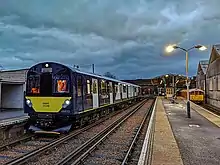| British Rail Class 484 D-Train | |
|---|---|
 Island Line Class 484 at Shanklin | |
 Class 484 passenger saloon | |
| In service | 1 November 2021 – present |
| Manufacturer |
|
| Family name | D-Train |
| Replaced | Class 483 |
| Constructed | 2020–2021 |
| Number built | 5 |
| Number in service | 5 |
| Formation | 2 cars per unit |
| Fleet numbers | 484001–484005 |
| Operators | Island Line |
| Depots | Ryde |
| Lines served | Island Line, Isle of Wight |
| Specifications | |
| Car body construction | Aluminium[1] |
| Car length | 18.372 m (60 ft 3 in)[2] |
| Width | 2.840 m (9 ft 4 in)[2] |
| Height | 3.630 m (11 ft 11 in)[2] |
| Doors | Single-leaf sliding pocket (each 1.127 m (3 ft 8 in) wide)[2] |
| Wheel diameter | 790–710 mm (31.10–27.95 in) (new–worn)[2] |
| Wheelbase |
|
| Maximum speed |
|
| Traction motors | 8 × Traktionssysteme Austria TME 32-43-4 56 kW (75 hp)[3] |
| Power output | 448 kW (601 hp) |
| Electric system(s) | 750 V DC third rail[4] |
| Current collector(s) | Contact shoe |
| UIC classification | Bo′Bo′+Bo′Bo′ |
| Bogies | Bombardier[1] |
| Braking system(s) | Electro-pneumatic |
| Coupling system | Wedglock[2] |
| Multiple working | Within class |
| Track gauge | 1,435 mm (4 ft 8+1⁄2 in) standard gauge |
The British Rail Class 484 D-Train is a class of electric multiple unit built by rolling stock manufacturer Vivarail which operates on the Island Line on the Isle of Wight. Based on the British Rail Class 230 diesel multiple unit, the units are part of the Vivarail D-Train family, converted from London Underground D78 Stock originally manufactured in the late 1970s and early 1980s by Metro-Cammell.
Five units have been converted for the Island Line to replace the Class 483 sets, with the first delivered for testing in late 2020 and the second in May 2021. The line closed in January 2021 for upgrade works and was originally scheduled to reopen on 1 April 2021 with the new fleet of trains,[5] but delays to the required infrastructure work as a result of the COVID-19 pandemic extended the shutdown period by six weeks to 13 May 2021,[6] and then problems with software on the trains further delayed their introduction.[7] The line reopened to passengers using the Class 484 stock on 1 November 2021.[8]
History
The Island Line, an 8+1⁄2-mile (13.7 km) long rail route on the Isle of Wight between Ryde and Shanklin, has historically been limited in the type of rolling stock that can be operated due to clearance issues, particularly height in the Ryde Tunnel between Ryde Esplanade and Ryde St John's Road, which has had its trackbed raised numerous times over the course of its history to mitigate the risk of flooding.
These limitations continued even after electrification in 1966. Since electrification, the Island Line has used repurposed former London Underground stock, beginning with the British Rail Classes 485 and 486, built as 1923 tube stock, which were used from 1966 to 1989. Gauging trials took place in the 1960s to determine whether Class 503 units were suitable for use on the route, but without success.[9] From 1989 onward, rail services were operated using Class 483 units, which originated as 1938 tube stock and last ran on the Northern line.[10]
However, these units were first introduced on the Underground in 1938 and, by 2019, were more than eighty years old. This made them increasingly difficult to maintain, with the original fleet of eight eventually reduced to four in service, with another two retained as spares donors.[11][12] As a consequence, replacement of the rolling stock became an urgent priority - this requirement was eventually linked with a wider need to invest in improvements in the line itself, and saw suggestions that it might be converted to a light rail operation, or even a bus rapid transit route.[13]
However, in 2019, it was announced that the existing third rail operation would be retained, with a total of £26m invested to make improvements. A significant proportion of this would be used on the procurement of a fleet of new trains, which it was announced would be sourced from Vivarail's D-Train platform.[14][15][16]
The first passenger-carrying Class 484 departed Ryde St John's Road railway station at 05:35 on 1 November 2021.[8]
Trains
The Class 484 units are two-car trains built using the existing bodyshells and bogies of former London Underground D78 stock units modified for use on the National Rail network. These have similar features to the Class 230 trains from the same family, with Wi-Fi, power sockets and CCTV. The D78 Stock is similar in terms of height to other National Rail rolling stock in Great Britain and taller than the previous Class 483, and having undertaken a survey of the route, Vivarail confirmed that its proposed units were capable of traversing the Ryde Tunnel.[17]

The first of the total of five units was due to be delivered for testing in the summer of 2020.[18] The first unit arrived on the Isle of Wight on 19 November 2020 via ferry.[19][20]
Fleet details
Each unit is formed of two Driving Motor vehicles.
| Class | Operator | Qty. | Year converted | Cars per unit | Unit numbers |
|---|---|---|---|---|---|
| 484 | Island Line | 5 | 2020–2021 | 2 | 484001–484005 |
| Unit | North end vehicle | South end vehicle |
|---|---|---|
| 484001 | 131 (ex 7086) | 231 (ex 7011) |
| 484002 | 132 (ex 7068) | 232 (ex 7002) |
| 484003 | 133 (ex 7051) | 233 (ex 7083) |
| 484004 | 134 (ex 7074) | 234 (ex 7111) |
| 484005 | 135 (ex 7124) | 235 (ex 7093) |
Gallery
 The first car of Class 484 leaves Wightlink's Fishbourne terminal in 2020. It will be taken to Ryde Traincare Depot for inspection and testing.
The first car of Class 484 leaves Wightlink's Fishbourne terminal in 2020. It will be taken to Ryde Traincare Depot for inspection and testing. Class 484 stands next to Class 483, illustrating the difference in loading gauge between the ex-deep-level Tube Class 483 unit and the ex-sub-surface Class 484 unit.
Class 484 stands next to Class 483, illustrating the difference in loading gauge between the ex-deep-level Tube Class 483 unit and the ex-sub-surface Class 484 unit. Island Line Class 484 arrives at Shanklin in 2022
Island Line Class 484 arrives at Shanklin in 2022 Internal view of an Island Line Class 484.
Internal view of an Island Line Class 484.
See also
Notes
- 1 2 McCaffrey, Sam (1 May 2015). "'They don't make trains like this anymore'". Rail Technology Magazine. Manchester: Cognitive Publishing. Archived from the original on 27 June 2015. Retrieved 10 December 2022.
- 1 2 3 4 5 6 7 "D78 Stock". Rolling Stock Information Sheets (PDF) (2nd ed.). London Underground Limited. March 2007. Archived from the original (PDF) on 6 March 2016. Retrieved 10 December 2022.
- ↑ "British Rail Class 230 – diesel-electric and battery MU overhaul for VivaRail and RDC". Traktionssysteme Austria. Retrieved 7 June 2023.
- ↑ David Burroughs (16 September 2019). "Fleet and track upgrades in £26m Isle of Wight investment". International Railway Journal. Archived from the original on 28 November 2020. Retrieved 7 January 2020.
- ↑ Marriott, Alan (20 August 2020). "Isle of Wight faces three months with no trains on Island Line". Isle of Wight County Press. Newsquest. Archived from the original on 21 August 2020. Retrieved 21 August 2020.
- ↑ "Covid: Isle of Wight rail overhaul delayed by pandemic". BBC News. 12 February 2021. Archived from the original on 12 February 2021. Retrieved 12 February 2021.
- ↑ "Train issues delay Island Line reopening". SWR. 27 April 2021. Archived from the original on 27 April 2021. Retrieved 27 April 2021.
- 1 2 "Isle of Wight rail line reopens 10 months after £26m overhaul". BBC News. 1 November 2021. Retrieved 2 November 2021.
- ↑ "Ryde Rail - a history of tube trains on the Isle of Wight". Railway Modeller. Vol. 70, no. 827. September 2019. p. 779.
- ↑ Hardy 2003, p. 60.
- ↑ Marsh, Phil (February 2019). Milner, Chris (ed.). "DfT decision on Island Line future deferred for three months". Headline News. The Railway Magazine. Vol. 165, no. 1415. Horncastle: Mortons Media Group (published 6 February 2019). p. 6. ISSN 0033-8923.
- ↑ Anon (26 March 2018). "Third Ryde Tube: Transfer Troublesome". London Reconnections. Archived from the original on 26 March 2018. Retrieved 27 March 2018.
- ↑ "IS THE FUTURE TRAMS AND STEAM TRAINS INTO RYDE?". islandecho.co.uk. Island Echo. 5 February 2016. Archived from the original on 25 February 2016. Retrieved 18 February 2016.
- ↑ Isle of Wight line’s future secured with £26m investment Archived 16 September 2019 at the Wayback Machine Railway Gazette International 16 September 2019
- ↑ "£26m investment announced for Isle of Wight rail line". BBC News. 16 September 2019. Archived from the original on 16 September 2019. Retrieved 16 September 2019.
- ↑ "UK's oldest train fleet updated with £26m investment into Isle of Wight's railway". South Western Railway. Archived from the original on 16 September 2019. Retrieved 16 September 2019.
- ↑ "Vivarail to supply new train fleet for the Island Line". Rail Insider. 17 September 2019. Archived from the original on 5 June 2020. Retrieved 5 June 2020.
- ↑ Honey, Jade. "UK's oldest train fleet updated with £26m investment into Isle of Wight's railway". Isle of Wight Observer. Retrieved 16 September 2019.
- ↑ The first refurbished Class 484 trains arriving on the Isle of Wight. Archived 2 May 2021 at the Wayback Machine Isle of Wight Council. Retrieved 20 November 2020.
- ↑ "Isle of Wight receives first 'new' train for Island Line". BBC News. 20 November 2020. Retrieved 25 July 2021.
References
- Hardy, Brian (2003). Tube Trains on the Isle of Wight. Harrow Weald, Middlesex: Capital Transport. ISBN 978-1-85414-276-4.
External links
- Class 484 - South Western Railway
- Video showing the delivery of Unit 484001 to the Isle of Wight South Western Railway.